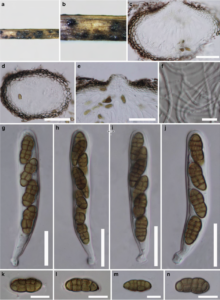Alternaria ethzedia E.G. Simmons, Mycotaxon 25(1): 300 (1986)
≡ Lewia ethzedia E.G. Simmons, Mycotaxon 25(1): 299 (1986)
Facesoffungi number: FoF00918; Fig. 1
Saprobic on dead stem. Sexual morph: Ascomata 96 – 162 μm high × 138 – 226 μm diam. (x̄ = 131 × 193 μm,n = 10), scattered to clustered, semi-immersed toerumpent, dark brown to black, globose to subglobose, coriaceous, ostiolate. Ostiole central, papillate. Peridium 20 – 38 μm (x̄ = 26.8 μm, n = 10) wide, comprising 3 – 5 layers of light to dark brown thick – walled cells of textura angularis. Hamathecium of 1.5 – 3 μm wide, cellular, septate pseudoparaphyses, anastomosing between and above asci. Asci 73 – 90 × 11.5 – 13.5 μm (x̄ = 82×12.5 μm, n = 20), (4 – 6 –)8 – spored, bitunicate, fissitunicate, cylindrical to subcylindrical, straight or somewhat curved, with a short pedicel, apically rounded, with a minute ocular chamber. Ascospores 15.5 – 20 × 7 – 8.5 μm (x̄ = 18 × 7.8 μm, n = 30), overlapping uni to biseriate, pale brown, ellipsoid to fusoid, muriform, initially with 3 transverse septa, become 4 – 5 at maturity, central 4 rows with a single longitudinal septum, constricted at the central septum, slightly constricted at the other septa, smooth – walled, surrounded by a mucilaginous sheath. Asexual morph: see asexual morph description in Simmons (1986).
Material examined – ITALY, Forlì-Cesena Province, Fiumicello di Premilcuore, on dead stem of Brassica nigra (Brassicaceae), 13 January 2013, Erio Camporesi IT 1007 (MFLU 15–1411), ex-type living culture, MFLUCC 13– 0404, CFTCC.

Fig. 1 Alternaria ethzedia (MFLU 15–1411) a, b Appearance of ascomata on the host surfacess c, d Sections through ascomata e Ostiole f Pseudoparaphyses g – j Bitunicate asci k – n Ascospores. Scale bars: c – e = 50 μm, f = 10 μm, g – j = 25 μm, k – n = 10 μm.
